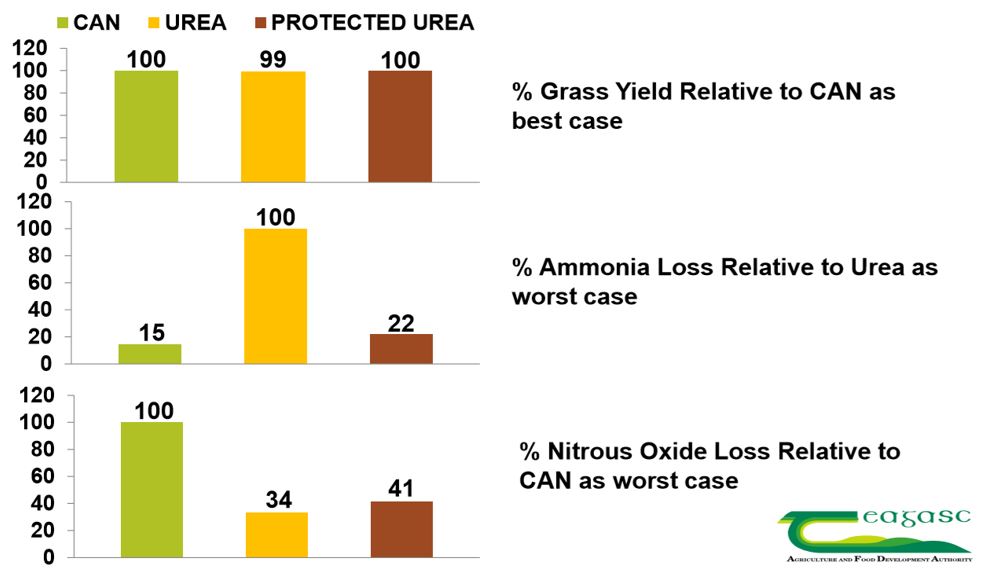This season, more and more Irish farmers are heeding the advice of Teagasc and switching their nitrogen source from urea or calcium ammonium nitrate (CAN), to protected urea.
Here we look at why farmers are making the switch, what should be considered before trying it on farm, and share some in-depth insight into a new protected urea product, Limus, which was introduced to the market earlier this year.
Teagasc advice
Protected urea has been identified by Teagasc as a key tool to reduce emissions in Irish agriculture.
Teagasc advises that use of protected urea will result in a significant reduction in ammonia losses in both grass and tillage cropping, when compared to standard urea, as well as an important reduction in nitrous oxide losses in grassland, when compared to CAN.
Both are key targets in the government’s Climate Action Plan. Ammonia is a pollutant that contributes to poor air quality, leading to negative impacts on human health, while nitrous oxide is a powerful greenhouse gas (GHG), 298 times more potent than carbon dioxide.
In addition to the environmental benefit, reducing the amount of nitrogen lost to the atmosphere in the form of ammonia and nitrous oxide also has a clear financial benefit, as more nitrogen stays in the soil available for uptake.
Economic advantage
CAN is often considered the most reliable source of nitrogen for securing high yields. However, Teagasc trials have shown that protected urea gives the equivalent yield to CAN on Irish grassland and is better value per unit of nitrogen, offering an economic advantage, as well as an environmental one.
What is protected urea?
Teagasc defines protected urea as urea which is treated with a urease inhibitor. The urease inhibitor can be either coated onto the outside of the urea granule or incorporated into the urea granule melt during manufacture.
Urease inhibitors have been used for decades globally, with very high use rates in some markets. For example, in the US around a third of the urea used is treated with an inhibitor.
It’s worth noting that there are only three urease inhibitors registered globally: NBPT; NPPT; and 2-NPT. All protected urea products contain one or two of these active ingredients. A full list of registered urease inhibitor products in Ireland can be found on the Teagasc website.
What is Limus protected urea?
BASF, a leading supplier of crop protection products to the Irish market, has recently entered the protected urea market with the launch of a new urease inhibitor called Limus.
Limus is the only urease inhibitor available that contains two active ingredients: NBPT; and NPPT, and comes in a unique, patent protected formulation, both of which enhance the performance of the product.
The innovative, liquid formulation also ensures that the product permeates into the urea granules, which protects them from the losses that can occur when spreading urease inhibitor products applied as a coating.
As with all fertilisers, it is important to calibrate your spreader before use and it is recommended to use suitable personal protective equipment (PPE). Limus protected urea does not require different handling precautions to other fertilisers.
Limus protected urea is available from four producers in Ireland and is approved by Teagasc. The granules are a light-yellow colour and the BASF logo will be on the bag.
Trial results
Results from 74 different BASF trials demonstrate that Limus protected urea delivers equivalent yields to CAN, reinforcing the findings shown by Teagasc.
BASF has also evaluated the performance compared to standard urea and found that Limus protected urea reduced ammonia losses by up to 98% and delivered an average yield increase of 5% as a result of the reduction of ammonia losses.
Below is a demonstration of Limus protected urea in action, compared to standard urea.
How does protected urea work?
Urea is not readily available to plants and initially needs to be converted into ammonium. This is done by urease enzymes in the soil that bind to the urea.
Without sufficient rainfall post application, the ammonium concentration around the urea granule increases, leading to a localised increase in soil pH. As a result, the ammonium is converted into ammonia gas and can be lost to the atmosphere.
Urease inhibitors temporarily bind to these enzymes so they can’t bind to the urea, preventing the localised spike in pH and reducing the losses of ammonia.
However, different urease enzymes require different urease inhibitors. Limus is the only urease inhibitor available with two active ingredients (NBPT and NPPT), enabling it to bind to a wider variety of urease enzymes. As a result, losses are more effectively minimised.
BASF’s Richard Corden commented on this, saying: “Limus protected urea offers a good technical solution to farmers using either urea or CAN.
“Trials consistently show that Limus protected urea outperforms urea and works as reliably as CAN, giving equivalent yield performance while generally being cheaper, making Limus protected urea a reliable, cost-effective and environmentally friendly choice on farm.”
Additional information
For more information on Limus protected urea, see: www.agricentre.basf.ie/limus; or contact your local agri merchant.



